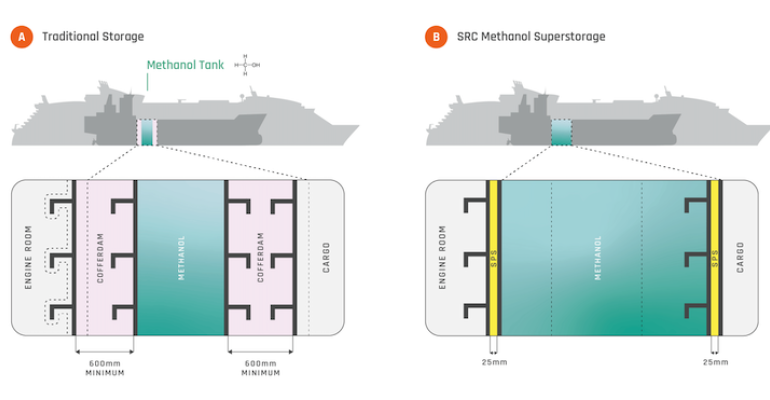According to many experts, the chemical – CH3OH – offers significant benefits as a marine fuel of the future. Currently available in about 120 ports around the world, it is easy to store and handle on board ship, and is suitable both for newbuildings and conversions.
Earlier this year, Clarkson reported 14% of tonnage on order as methanol-capable, compared to a 22% share for liquefied natural gas. The analyst has estimated that 1,200 ships could be powered by methanol by 2030.
Although it is not widely available yet in its ‘green’ form, fuel providers are focusing on new facilities to produce methanol using sustainable energy sources. Potentially, therefore, it is a carbon-neutral fuel with combustion technology that has been operating satisfactorily since Stena Line converted the ferry, Stena Germanica, to dual-fuel methanol/diesel operation in 2015.
One drawback of methanol, however, is that its energy density is 2.4 times less than diesel and, as a low flashpoint fuel, the IMO’s Maritime Safety Committee MSC.1/Circ.1621 regulation requires 600mm cofferdams around fuel tanks. Now, though, two technology providers offer options both for newbuildings and methanol conversions.
At Europort recently, Estonia-based SRC Group launched Methanol Superstorage, a fuel tank option that does not require cofferdams, saves space, and maximises methanol fuel volumes. It is based on well-established Sandwich Plate System (SPS) technology consisting of two steel plates with a solid elastomer core approved years ago by Lloyd’s Register (LR).
Existing fuel tanks can be gas-freed and modified, with SPS applied either inside or outside existing tank structures. The fact that cofferdams are not required enables an increase in fuel tank capacity of up to 85% within the same space.
Speaking to Seatrade Maritime News recently, SRC Group CEO, Hannes Lilp declared that methanol provides the best option for reducing greenhouse gases from ships at pace. Methanol Superstorage replaces the requirement for cofferdams by fitting a 25mm-thick SPS barrier to protect the fuel tank from fire and as a triple barrier against leakage, he said.
Although the system was developed primarily with the retrofit market in mind, Lilp reveals that enquiries so far have been split almost equally between retrofits and newbuildings. A significant and surprising level of enquiry has come from the superyacht sector, Lilp revealed.
Meanwhile, in a separate development, LR together with Hamburg-based SDC Ship Design and Consult have revealed a new system to install ballast water tanks instead of cofferdams around methanol fuel tanks, thereby saving space. The arrangement follows a retrofit project in which the partners jointly developed the system.
SDC’s Managing Director, Michael Waechter, noted: “It must be in everyone’s interest to find simple and therefore efficient solutions for the implementation of alternative fuels in order to speed up the transition to net-zero shipping. These solutions must not compromise safety in any way and should be based on the respective physical/chemical properties of the fuels. The developed solution helps us to accommodate more methanol capacity in less space and thus increases the efficiency of the ship.”
Colin Rawlins, LR’s Strategic Business Partner and Senior Representative for Germany, said: “LR is pleased to unveil its innovative concept for the installation of methanol fuel tanks without the requirement for cofferdams. This development will allow both new construction projects and conversions to utilise space otherwise taken up by cofferdams to install methanol as fuel technology, thereby helping to accelerate the maritime energy transition with easier adoption of alternative fuels such as methanol.
Copyright © 2024. All rights reserved. Seatrade, a trading name of Informa Markets (UK) Limited.
Add Seatrade Maritime News to your Google News feed.  |

